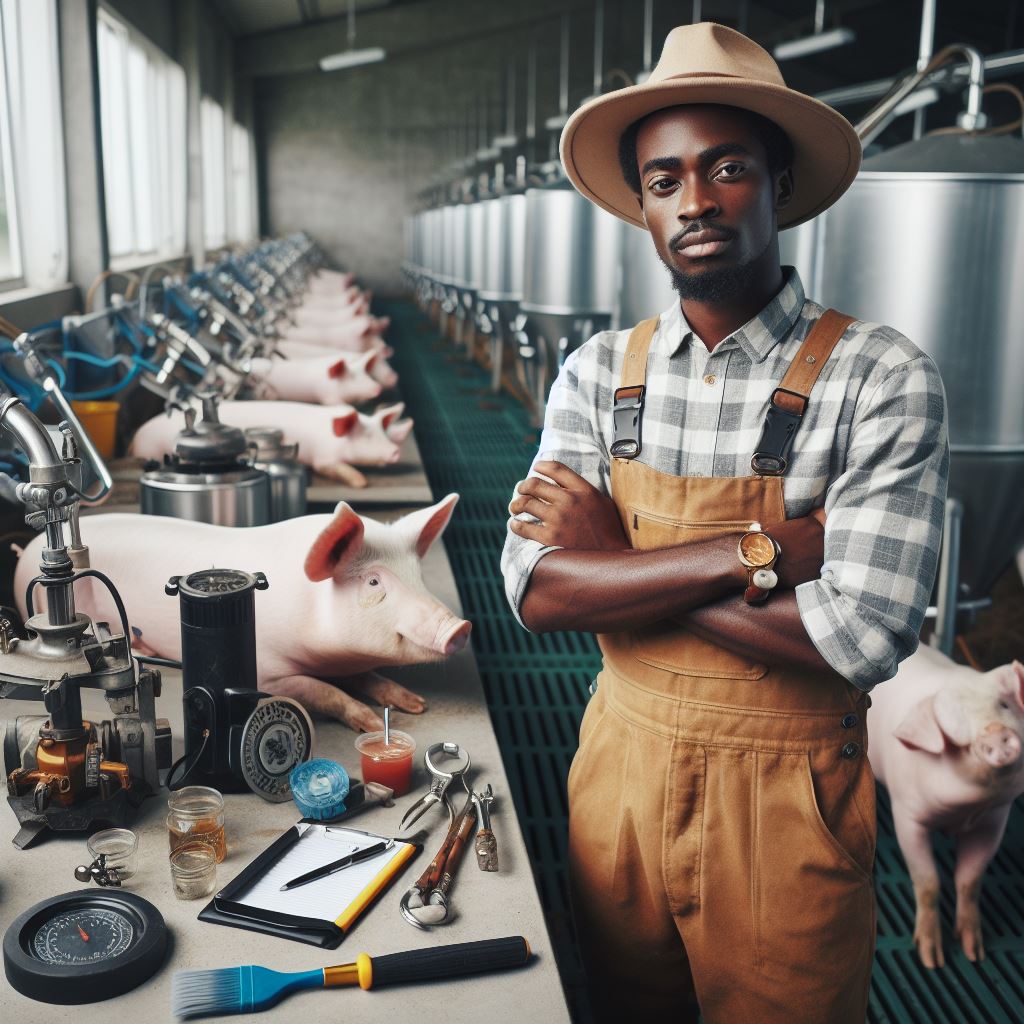Introduction
A. Innovative Wool Shearing Equipment Update
Staying updated with the latest equipment in wool shearing is crucial for several reasons.
Efficient and state-of-the-art tools can significantly improve the quality of shearing, increase productivity, and reduce the physical strain on workers.
B. The importance of staying updated with the latest equipment in wool shearing
In an industry where time and precision are paramount, utilizing innovative wool shearing equipment is vital.
Upgraded tools enable shearers to execute their tasks with greater accuracy and speed, leading to better outcomes for both the shearer and the sheep.
Outdated tools and techniques can cause unnecessary stress to the animals and potentially harm their welfare.
Not only can modern equipment enhance the overall shearing process, but it can also promote the safety and well-being of the workers.
Advanced tools are designed with ergonomic features that minimize physical strain and repetitive motion injuries.
By using the latest technology, shearers can safeguard their health and prolong their careers in the industry.
Furthermore, keeping up with advancements in wool shearing equipment allows shearers to stay competitive in the market.
Clients and wool buyers seek professional shearers who possess the most efficient tools and can deliver high-quality results.
By investing in new equipment and staying updated, shearers can attract more clients and maintain their reputation as skilled artisans.
In essence, the significance of staying updated with the latest equipment in wool shearing cannot be overstated.
It directly impacts the quality of shearing, animal welfare, worker safety, and professional competitiveness.
Embracing innovation and adopting new tools are essential for the sustainable growth of the wool industry.
Traditional Wool Shearing Equipment
A. Commonly used traditional wool shearing equipment
- Hand Shears: This type of equipment requires manual effort to shear wool from sheep.
- Blade Shears: Consisting of two comb-like blades, it requires steady hand movement to shear wool.
- Electric Shears: Powered by electricity, these shears provide a faster and more efficient wool shearing process.
B. Limitations and challenges faced with traditional equipment
- Time-consuming: Using hand shears or blade shears necessitates more time and effort to shear a large number of sheep.
- Fatigue: Manual shearing can lead to physical fatigue and strain on the shearer’s body.
- Inconsistent cuts: Achieving uniform wool cuts with traditional equipment can be challenging, leading to uneven wool growth and appearance.
- Precision: Due to the manual nature of traditional shearing equipment, achieving precision in the cuts becomes difficult.
- Risk of injuries: Hand shears and blade shears pose a higher risk of accidental injuries to both the shearer and the sheep.
- Limited productivity: Traditional shearing equipment allows for a limited number of sheep to be sheared in a given time, hampering overall productivity.
- Maintenance: Traditional shearing equipment requires regular sharpening, lubrication, and maintenance to ensure optimal performance.
Despite its historical significance, traditional wool shearing equipment faces several limitations and challenges.
Transform Your Agribusiness
Unlock your farm's potential with expert advice tailored to your needs. Get actionable steps that drive real results.
Get StartedThe advent of innovative wool shearing equipment aims to overcome these drawbacks and revolutionize the wool industry.
With the advancements in technology, modern wool producers and shearers have access to highly efficient and sophisticated shearing equipment.
These innovative tools are designed to enhance productivity, improve the quality of wool, and provide a more comfortable experience for both the shearer and the sheep.
Innovative Wool Shearing Equipment
A. Introduction of the concept of innovative wool shearing equipment
- Mechanical Shears: These electric-powered shears incorporate advanced cutting mechanisms to provide precise and faster wool shearing.
- Pneumatic Shears: Using compressed air, these shears offer increased speed and efficiency in shearing wool.
- Ergonomic Handling Tools: Innovative tools such as ergonomic handpieces and combs reduce the strain on the shearer’s body.
- Automated Shearing Systems: These systems utilize robotics and advanced technology to fully automate the wool shearing process.
B. Advantages and benefits of innovative equipment
- Increased productivity: Innovative shearing equipment enables shearers to shear more sheep in less time, leading to higher productivity.
- Improved wool quality: Precise cuts achieved by innovative equipment result in better wool quality and uniformity.
- Enhanced animal welfare: The use of innovative tools reduces the risk of injuries to both shearers and sheep, improving animal welfare.
- Reduced physical strain: Ergonomic handling tools minimize physical strain on shearers, promoting their well-being and health.
- Time-saving: Advanced equipment streamlines the shearing process, saving valuable time for shearers and farmers.
- Consistency: Innovative equipment ensures consistent and uniform wool cuts, providing a better overall appearance.
- Ease of use: Modern shearing equipment is designed to be user-friendly, allowing shearers to operate them with ease.
The introduction of innovative wool shearing equipment marks a significant milestone in the wool industry.
These advanced tools not only address the limitations of traditional equipment but also propel the industry forward with increased efficiency, productivity, and animal welfare.
In fact, traditional wool shearing equipment has served its purpose for many years, but it comes with various limitations and challenges.
However, with the emergence of innovative shearing equipment, the wool industry can embrace a new era of efficiency, precision, and sustainability.
By adopting these tools, shearers and wool producers can optimize their operations while prioritizing the welfare of the sheep.
Need for Innovation in Wool Shearing
In the dynamic landscape of the wool shearing industry, innovation stands as the linchpin for progress.
Here, we shed light on the pressing need for advancements in shearing equipment and explore the myriad benefits they promise.
A. The Need for Innovation
- Efficiency Enhancement: Traditional shearing methods often lack the efficiency needed to meet modern demands.
- Labor Intensiveness: Conventional shearing processes heavily rely on manual labor, contributing to high operational costs.
- Animal Welfare: Innovations can address concerns related to the stress animals endure during conventional shearing, fostering a more humane approach.
- Precision Shearing: Modern markets demand high-quality wool, necessitating equipment that ensures precise and consistent shearing results.
- Safety Measures: Outdated tools may pose risks to both shearers and the sheep, making safety a critical factor in innovation.
B. Potential Benefits of Innovative Equipment
- Time Savings: Advanced shearing equipment can significantly reduce shearing time, enhancing overall productivity.
- Cost Efficiency: Automation and improved technology contribute to lower operational costs, making the industry more financially sustainable.
- Quality Improvement: Innovations enable shearers to achieve superior wool quality, meeting the stringent standards of the market.
- Reduced Environmental Impact: Eco-friendly materials and energy-efficient designs can minimize the industry’s ecological footprint.
- Skill Enhancement: User-friendly interfaces and intuitive designs empower shearers, bridging the gap between traditional and modern skill sets.
- Global Competitiveness: Embracing innovation positions the industry on a global stage, fostering competitiveness in international markets.
- Data-Driven Decision Making: Smart shearing equipment equipped with sensors provides valuable data for better decision-making and strategic planning.
- Adaptability to Trends: Innovations allow the industry to adapt swiftly to changing consumer preferences and market trends.
To sum it up, the call for innovation in wool shearing equipment is not just a desire for modernization; it’s a strategic necessity.
By addressing inefficiencies and embracing cutting-edge technology, the industry can not only survive but thrive in an ever-evolving market.
The benefits are not just economic; they extend to the well-being of both the shearer and the sheep, ensuring a sustainable and humane future for wool production.
Overview of Innovative Wool Shearing Equipment
A. Introduction to some of the latest advancements in wool shearing equipment
These advancements in wool shearing equipment have revolutionized the industry, offering numerous benefits to both shearers and sheep farmers.
They address the challenges faced with traditional equipment, resulting in enhanced productivity, animal welfare, and overall satisfaction.
1. Automatic Shearing Systems
Automatic shearing systems have proven to be game-changers.
These systems utilize advanced robotics and computer algorithms to shear sheep automatically.
They eliminate the need for manual shearing, reducing the labor-intensive nature of the process.
With increased speed, these systems can significantly improve the efficiency of wool shearing.
2. Laser-guided Shears
Laser-guided shears have also made a remarkable impact.
By using lasers for guidance, shearers can achieve precise and accurate cuts.
This ensures the quality of the wool remains intact while minimizing the risk of injuries to the animals.
The incorporation of laser technology has revolutionized the shearing process, making it more efficient and effective.
3. Ergonomic Tools
Furthermore, ergonomic tools have been developed to address the physical strain experienced by shearers.
Showcase Your Farming Business
Publish your professional farming services profile on our blog for a one-time fee of $200 and reach a dedicated audience of farmers and agribusiness owners.
Publish Your ProfileThese tools have specially designed handles that reduce strain and fatigue, allowing shearers to work comfortably for longer periods.
By prioritizing the shearers’ well-being, these innovations not only improve their experience but also enhance their productivity.
4. Pneumatic Clippers
Pneumatic clippers are another noteworthy advancement in wool shearing equipment.
These clippers use compressed air to power the blades, resulting in faster and smoother shearing.
This not only saves time but also reduces stress on both the shearers and the sheep.
Pneumatic clippers provide a more comfortable shearing experience, benefiting both the animals and the shearers.
5. Wireless Communication
Wireless communication systems have also been introduced to improve coordination among shearers.
By allowing shearers to communicate wirelessly, they can synchronize their movements and work more efficiently as a team.
This level of coordination ultimately leads to better results and a more streamlined workflow.
B. How these innovations address the challenges faced with traditional equipment
- Improved Efficiency: Automatic shearing systems and laser-guided shears significantly speed up the shearing process, reducing labor time and costs.
- Precision and Quality: Laser-guided shears ensure precise cutting, maintaining the quality of wool and reducing the risk of injuries to sheep.
- Comfort and Well-being: Ergonomic tools prioritize shearers’ well-being, reducing strain and fatigue, thus enhancing their overall comfort during shearing.
- Enhanced Performance: Pneumatic clippers provide smoother shearing, minimizing stress on both the shearers and the sheep.
- Streamlined Communication: Wireless communication between shearers allows for better coordination, leading to improved efficiency and a smoother workflow.
Generally, the latest advancements in wool shearing equipment offer significant benefits to the industry.
From automatic shearing systems to laser-guided shears, ergonomic tools, pneumatic clippers, and wireless communication, these innovations address many challenges faced with traditional equipment.
They improve efficiency, precision, comfort, and teamwork, revolutionizing the wool shearing process for both shearers and sheep farmers.
Examples of Innovative Wool Shearing Equipment
In the world of wool shearing, there have been several innovative advancements in equipment that have revolutionized the way sheep farmers shear their animals.
These advancements have not only made the process more efficient but also improved animal welfare.
In this section, we will discuss some specific examples of innovative wool shearing equipment available in the market, outlining their features and advantages.
A. Handheld Shearing Machines
- The Heiniger Evo Handheld Shearing Machine is a versatile tool that offers precision and control during the shearing process.
- With its lightweight and ergonomic design, the Heiniger Evo reduces strain on the shearer’s hand and arm.
- It features a powerful motor that delivers consistent cutting performance, allowing for faster shearing.
- The Evo also has adjustable blade tension and quick blade-change capabilities, making maintenance hassle-free.
- Another innovative handheld shearing machine is the Lister Star. It is known for its quiet operation and low vibration levels.
- The Lister Star is designed with a slim handle for comfortable grip, enabling shearers to maneuver easily around the sheep.
- It has a durable body construction and an efficient air-flow system that prevents overheating during prolonged use.
B. Electric Shearing Machines
- The Heiniger Xpert Electric Shearing Machine is a high-performance tool suitable for professional shearers.
- It is equipped with a powerful motor and a ventilated head to keep the machine cool even during extended shearing sessions.
- The Xpert also features a patented connection between the handpiece and downtube, reducing vibration transfer and increasing comfort.
- It has an easy-to-use blade tensioning system and a durable body that ensures reliability and longevity.
- Another innovative electric shearing machine is the Lister Fusion. It combines power, precision, and control in one tool.
- The Fusion features a unique hybrid drive system that optimizes power output and reduces handpiece weight.
- It has an LCD screen for monitoring speed and a variety of cutting options to suit different sheep breeds.
These innovative wool shearing equipment examples offer a range of features and advantages that make the shearing process more efficient and comfortable for both shearers and animals.
The handheld machines provide precision and control, while the electric machines deliver power and durability.
With the advancements in technology, wool shearing has become a quicker and more efficient process, reducing stress on both the shearers and the sheep.
These innovative tools not only benefit the shearers in terms of productivity but also ensure the welfare of the animals by minimizing discomfort and maximizing safety.
Investing in innovative wool shearing equipment is a wise choice for sheep farmers who want to improve their shearing operations.
By using these advanced tools, they can streamline their processes, increase productivity, and ultimately contribute to the sustainability of the wool industry.
Read: Kidding in Goats: Managing Births

Impact of Innovative Equipment on Wool Shearing Process
Improved Efficiency and Productivity
Innovative equipment provides various benefits that enhance wool shearing processes.
Innovative wool shearing equipment, such as automated clippers, can significantly reduce the time required for shearing.
This increased efficiency allows shearers to handle more sheep within a given timeframe.
The use of innovative equipment also improves the overall productivity of wool shearing operations.
With enhanced efficiency, shearers can complete their work faster, increasing the number of sheep they can shear in a day.
Shorter shearing times mean reduced labor costs and increased profitability for wool producers.
Furthermore, innovative equipment offers ergonomic designs and features that minimize physical strain on shearers.
By reducing shearers’ fatigue and discomfort, the equipment contributes to a safer and healthier working environment.
Improved shearer comfort can lead to a higher retention rate in the shearing industry, addressing the shortage of skilled shearers.
Impact on Animal Welfare
The use of innovative equipment can positively affect the well-being of animals during wool shearing.
Traditional shearing methods may cause stress, discomfort, and even injuries to sheep due to manual handling and outdated tools.
In contrast, innovative equipment provides more gentle and efficient shearing techniques, minimizing potential harm to the animals.
For example, advanced machine technologies can automatically adjust cutting depths based on wool length, avoiding accidental cuts on sheep’s skin.
Moreover, modern equipment offers features like rotary blades, reducing the occurrence of cuts and abrasions on the animals’ bodies.
The improved handling techniques and reduced stress level promote better welfare outcomes for the sheep.
Quality of Wool Produce
Innovative equipment can have a positive impact on the quality of sheared wool.
The precision and accuracy of advanced shearing equipment result in cleaner and more consistent wool cuts.
This enhanced precision ensures that no excess wool or uneven patches remain, resulting in higher-grade wool production.
Showcase Your Farming Business
Publish your professional farming services profile on our blog for a one-time fee of $200 and reach a dedicated audience of farmers and agribusiness owners.
Publish Your ProfileCleaner cuts also reduce the risk of contamination, such as dirt or feces, improving the overall purity of the wool.
Furthermore, innovative equipment often incorporates technologies that enhance the collection and separation of different wool grades.
This sorting process contributes to the production of higher-quality wool fibers, increasing their market value.
In review, the adoption of innovative wool shearing equipment has a profound impact on various aspects of the process.
Efficiency and productivity improvements benefit shearers, wool producers, and the overall profitability of the industry.
Moreover, the use of advanced equipment promotes better animal welfare conditions during the shearing process.
Finally, innovative equipment aids in producing higher-grade, cleaner, and more valuable wool fibers.
Overall, the integration of innovative equipment marks a significant advancement in the wool shearing industry.
Case Study: Successful Implementation of Innovative Equipment
A. Case Study: Pioneering Farmer Revolutionizes Wool Shearing
In the heart of rural New Zealand, visionary farmer Jack Thompson embraced the future by integrating cutting-edge wool shearing equipment into his traditional farming practices.
- Jack, a third-generation farmer, faced the challenge of increasing operational efficiency while maintaining high-quality wool production.
- After meticulous research, he opted for the latest robotic shearing technology, a decision that transformed his entire shearing process.
- The new equipment, equipped with advanced sensors and AI algorithms, significantly reduced shearing time while ensuring a uniform and clean cut.
- Jack’s flock, once wary of the automated contraption, quickly adapted, thanks to a thoughtful introduction and training program.
B. Positive Outcomes: The Unveiling of a New Era in Shearing
1. Enhanced Efficiency
- Shearing time reduced by 30%, allowing Jack to focus on other crucial aspects of farm management.
- Increased the overall annual wool yield by 15% due to more precise and consistent shearing.
2. Animal Welfare
- Stress levels among the sheep decreased, thanks to the gentler, more predictable movements of the robotic shearing arms.
- The automated system minimized the risk of nicks and cuts, ensuring the well-being of the flock.
3. Cost Savings
- Reduced labor costs by 20%, as the need for manual shearing was significantly diminished.
- Lowered veterinary expenses due to the decrease in stress-related health issues among the sheep.
4. Environmental Impact
- The automated system’s energy-efficient design aligned with Jack’s commitment to sustainable farming practices.
- Decreased water usage, as the streamlined shearing process required less post-shearing cleaning.
5. Technology Adoption
- Jack’s success story inspired neighboring farmers to explore innovative solutions, fostering a technological shift in the local agricultural community.
- The ripple effect extended to broader agricultural circles, sparking conversations about the benefits of embracing modern equipment.
In a nutshell, Jack Thompson’s bold move to embrace innovative wool shearing equipment not only catapulted his farm into a new era of efficiency but also set a precedent for sustainable and technology-driven farming practices.
The positive outcomes witnessed serve as a testament to the transformative power of progressive thinking in agriculture.
Read: Sheep & Goat Vaccination Schedules
Challenges and Considerations
A. Highlighting Challenges or Considerations Associated with Utilizing Innovative Equipment
- Initial costs of procuring innovative wool shearing equipment can be high.
- Adoption of new technology may require additional training for shearers to operate the equipment efficiently.
- Compatibility issues may arise between existing infrastructure and innovative equipment, leading to potential integration challenges.
- Reliability and durability of new equipment need to be thoroughly evaluated to ensure long-term functionality.
- Finding skilled technicians or specialists who can provide maintenance and repair services for the latest equipment can be a challenge in some regions.
- Unfamiliarity with new equipment may initially slow down the shearing process and require additional time for adjustment.
- Safety concerns related to the use of innovative equipment, such as accidental injuries or damage to the animal, need to be addressed.
- Environmental impact of the innovative equipment should be considered, including energy consumption or waste generation.
- The potential resistance to change from traditional shearers and the need for convincing them about the benefits of innovative equipment.
- Adequate storage and transportation arrangements need to be made for the equipment to prevent damage during transit.
B. Providing Tips or Suggestions for Addressing These Challenges
- Conduct a thorough cost-benefit analysis to assess the long-term financial viability of investing in innovative equipment.
- Arrange training sessions and workshops to familiarize shearers with the new equipment and its efficient operation.
- Collaborate with equipment manufacturers to ensure compatibility with existing infrastructure and provide necessary support during integration.
- Prioritize equipment with a proven track record and positive user feedback to ensure reliability and durability.
- Develop partnerships with technicians or maintenance services familiar with the latest equipment to ensure timely support.
- Gradually introduce the innovative equipment and allow shearers sufficient time to adapt and enhance their proficiency with practice.
- Implement comprehensive safety protocols and provide training on the safe use of innovative equipment to minimize any potential risks.
- Assess the environmental impact of the equipment and opt for models that are energy-efficient and have minimal waste generation.
- Communicate the advantages of innovative equipment to traditional shearers, emphasizing increased efficiency, productivity, and potential income growth.
- Develop suitable storage solutions and secure transportation mechanisms to safeguard the equipment during transit.
By addressing the challenges and considering the necessary considerations, the adoption and utilization of innovative wool shearing equipment can be successful.
It requires careful planning, collaboration, and training to ensure a smooth transition and to maximize the benefits of the technology.
Read: Safe Use of Chemical Fertilizers in Farms
Future Trends in Wool Shearing Equipment
The wool shearing industry is on the brink of a transformative era with cutting-edge advancements poised to revolutionize traditional practices.
A. Emerging Trends in Wool Shearing
- Precision Robotics: Expect an influx of robotic shearing systems that enhance precision and efficiency.
- Sensor Integration: Sensors will play a pivotal role, providing real-time data on wool quality and sheep welfare.
- Data Analytics: Harnessing big data will enable farmers to make informed decisions, optimizing shearing processes.
- Environmentally Friendly Solutions: The industry is shifting towards sustainable practices, including eco-friendly shearing equipment.
- Human-Machine Collaboration: Future equipment will facilitate seamless collaboration between shearers and advanced technologies.
B. Future Advancements and Implications
- AI-Powered Shearing: Artificial Intelligence will revolutionize shearing, adapting techniques based on individual sheep characteristics.
- Virtual Reality Training: Shearers will undergo immersive virtual reality training, refining their skills in a simulated environment.
- Nanotechnology Fabric: The development of nanotech-infused fabric will enhance the durability and performance of shearing equipment.
- Automated Health Monitoring: Shearing equipment will incorporate health monitoring systems for sheep, ensuring their well-being during the process.
- Autonomous Shearing Vehicles: Unmanned vehicles equipped with advanced shearing technology will navigate pastures, autonomously shearing flocks.
To summarize, the future of wool shearing equipment promises a paradigm shift, integrating cutting-edge technologies to elevate efficiency, sustainability, and animal welfare.
As the industry embraces these advancements, shearing will evolve into a streamlined, data-driven, and environmentally conscious process.
Read: Sustainable Landscapes: Agroforestry Essentials
Conclusion
A. Staying updated with the latest wool shearing equipment is crucial for successful shearing operations, maximizing efficiency, animal welfare, and overall productivity in the wool industry.
Modern shearing tools enhance precision, speed, and minimize stress on both sheep and shearers.
Improved ergonomic designs and advanced technologies contribute to a safer working environment, reducing the risk of injuries.
Additionally, updated equipment often incorporates sustainable practices, aligning with the industry’s evolving environmental standards.
Keeping abreast of innovations ensures that wool producers can maintain a competitive edge, meet evolving market demands, and contribute to the long-term sustainability of the wool production sector.
By exploring innovative options and embracing advancements in the field, shearers can improve productivity and efficiency.




